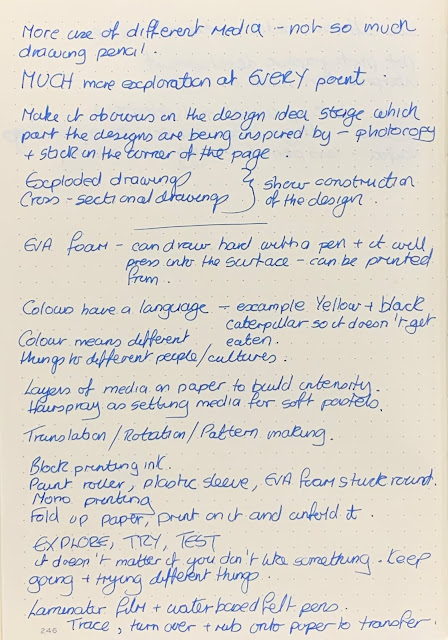Today was a full day of learning with
Pippa Lawler.
To start with, for the first two periods of the day, I had my whole senior class of seniors, which is a mixed class of Year 12 and Year 13 students.
Pippa worked with the whole class for those first two sessions and then with the 4 scholarship students (plus 1) and myself for the rest of the day.
Whole Class
Walking round the room
With the whole class, we started with movement activities.
- Walking anywhere around the room
- Walking in a circle keeping the same distance between us and and keeping to the same speed
- Repeat the last instruction but count backwards from 1000 in multiples of 7 - we all went wonky on this one!
It takes just as much brain capacity to make small decisions like what kind of pencil to use as it does to make big decisions. Don't sweat the small stuff. Don't take up brain space with stuff that doesn't matter.
Circle, square and triangle
We did drawing exercises involving just using a square, a triangle and a circle. Draw them in 20 different ways. Choose one and draw it 5 times - 3 the same size, 1 small, 1 big. Pattern one with lines. Pattern one with dots and circles.
Doodles
Take note of your doodling - this reveals your "signature style" a lot of the time. What people are saying to you comes out in your doodles. Try doodling as you listen to someone talk about themselves.
Think of a Dog
When people are asked to think of a particular thing then describe it, we all describe something different. Words are very personal thing, we think of different things when we hear the same words. Your brain attaches meaning to words and these meanings are all different and personal.
Go for a walk
Go for a walk round the quad armed with small pieces of sugar paper and oil pastels. Draw things that you notice. Come back to the room in 5 minutes.
Go to the same place with smooth paper and coloured pencils. Close your eyes and draw what you hear.
Rubbings
Tae a small piece of paper and some soft pastel and do rubbings of textures that you find. Take another piece of paper and try folding it to replicate that texture.
Using apps
Take photos of your work and put it through apps on you phone -
Paper Camera
The walk round the room exercises - that was to demonstrate heuristics. Circle, triangle, square = Bauhaus and form follows function (Walter Gropius)
Scholarship Group
The rest of the day (4 periods) was spent with the small group of students who are trying for scholarship DVC this year.
We spent a lot of time looking at things differently.
The rack of scissors
Pen on paper. Follow the outline of the rack of scissors with your eyes and follow that movement with the pen on the paper. Don't take the pen from the paper, it is a continuous line. Don't look at your drawing.
The spaces between
With marker pens on white paper. Look through the holes in the scissor handles and draw with the wide end of the marker the spaces between things.
Cut strips of paper, thread the strips through the holes and around the individual pieces.
Media
Torn paper against different papers to put work over both.
Press printing
Tissue paper coloured backgrounds - Think about the backgrounds, don't just go straight for plain white paper.
Soft pastel through template - cut / torn templates - found templates for pattern.
Create pattern using repeats and rotations.
Use less drawing pencil after the initial drawings. Use media to explore the starting points.
Use the design elements to explore with -
line, shape, form, colour, texture, pattern
Fill the page with work, exploring. Don't just put one or two drawings on there and leave it. Make sure every part is explored.
What if I ........?
We ended the day looking at electron microscope images of their chosen starting points. This got us thinking in very different directions.
T - is going to look at weaving (her starting point was peacocks)
C - is going to look at carvings of taniwha (her starting point was dragons)
K - is going to look at Roy Lichtenstein and Andy Wahol, looking especially at the dot pattern to create images (his starting point was the human face)
V - has electron microscope pictures of butterfly wings and needs to use less pencil and work looser. (his starting point was insects)
Some of the work from the session today ...
Quote from the day...
There is a place for every kind of weird
My notes from the day .....

















